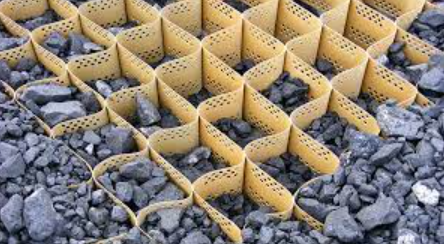- Understanding the Role of Geomembrane Liners in Waste Management
- Innovations in Geomembrane Liners for Water Management
- Geomembrane Liners: A Comprehensive Guide
- The Future of Geomembrane Liners in Civil Engineering
- Geomembrane Liners: Enhancing Landfill Stability
Manager:Alvin Wang
WhatsApp:+62 8983806051
Tel:+86 10-5797-1075
Email:steelwang@okorder.com
Address:3rd Floor, No.2 Building, No.1 Sanlihe Road
What are the different types of Geocells?
Introduction
Geocells have emerged as versatile solutions for various geotechnical applications, including slope protection. With their cellular structure and flexibility, geocells offer effective erosion control, soil stabilization, and slope protection. In this article, we'll explore the different types of geocells specifically designed for slope protection applications.

Understanding Geocell Slope Protection
Geocell slope protection involves the use of geocells to stabilize and reinforce slopes, preventing soil erosion and landslides. These innovative geosynthetic materials consist of interconnected cells that confine soil or aggregate, creating a stable surface. Geocell slope protection systems are widely used in civil engineering projects, infrastructure development, and environmental conservation efforts.
Types of Geocells for Slope Protection
1. Perforated Geocells
Perforated geocells feature regularly spaced perforations along the cell walls. These perforations facilitate efficient drainage, allowing water to flow through the geocell structure. Perforated geocells are particularly suitable for slope protection applications in areas with high rainfall or water runoff. By promoting effective drainage, perforated geocells help prevent hydrostatic pressure buildup behind the slope, reducing the risk of erosion and instability.
2. Textured Geocells
Textured geocells are designed with textured or patterned cell walls, enhancing soil-to-cell friction and interlocking. This textured surface provides additional stability and resistance against soil movement, making textured geocells ideal for steep slopes and areas prone to erosion. The enhanced soil confinement offered by textured geocells helps maintain the integrity of the slope, even under dynamic loading conditions.
3. High-Density Polyethylene (HDPE) Geocells
hdpe geocells are manufactured from high-density polyethylene, a durable and resilient material with excellent chemical and environmental resistance. These geocells offer superior strength and longevity, making them suitable for long-term slope protection applications. HDPE geocells can withstand harsh environmental conditions, including UV exposure, temperature fluctuations, and chemical exposure, ensuring reliable performance over the lifespan of the slope protection system.
4. Three-Dimensional (3D) Geocells
Three-dimensional geocells feature a three-dimensional honeycomb structure, providing increased soil confinement and reinforcement. These geocells are highly effective in stabilizing steep slopes, preventing soil erosion, and promoting vegetation growth. 3D geocells offer a balance between strength, flexibility, and permeability, making them versatile solutions for slope protection projects in various terrain conditions.
5. Cellular Confinement Systems (CCS)
Cellular confinement systems, also known as geocell reinforcement systems, utilize interconnected cells to confine and stabilize soil or aggregate materials. These systems can be filled with a wide range of infill materials, including soil, gravel, or concrete, depending on the specific slope protection requirements. CCS offer customizable solutions for slope stabilization, erosion control, and load support, making them suitable for a diverse range of applications, from highway embankments to coastal protection projects.
6. Biodegradable Geocells
Biodegradable geocells are designed to degrade over time, providing temporary slope protection while promoting vegetation establishment. These eco-friendly geocells are typically made from biodegradable polymers or natural fibers, offering an environmentally sustainable alternative to traditional geosynthetic materials. Biodegradable geocells help mitigate erosion, improve soil stability, and enhance biodiversity, making them ideal for environmentally sensitive areas and ecological restoration projects.

Conclusion
Geocells offer versatile solutions for slope protection, providing effective erosion control, soil stabilization, and reinforcement. By understanding the different types of geocells available for slope protection applications, engineers and designers can select the most suitable solution based on project requirements, site conditions, and environmental considerations. Whether it's perforated geocells for efficient drainage or biodegradable geocells for eco-friendly erosion control, geocell slope protection systems play a crucial role in sustainable infrastructure development and environmental conservation efforts."






